The history of Mestlin
The Thirty-Years-War left a destructed land behind. A reconstruction takes
place only slowly. In the following years, Mecklenburg has to suffer through a number of other smaller and bigger wars. In the 19th century, Mestlin
develops to a pure estate-village. Just like anywhere in Mecklenburg, many inhabitants emigrate. The situation for the rural population hardly improves
till World War II.
In1652, the effects of the Thirty-Years-War on Mestlin are, just like anywhere in Mecklenburg, tremendous.
Only 12 peasantries remain.
- 1654
- Rabble-law with embodiment of serfdom
After the rabble-law from 1645, that had already been enforced, the new "Rabble - Day-Laborer - Peasant - Shepherd - Tax- and
Victual-law" is being passed on November 14th, 1654. It consolidates the worst way of suppression of peasants by the aristocrats. A marriage, for
example, has to be allowed by the estate owner.
- 1658
- Schwedisch-Polnischer Krieg
In 1658, Imperial, Brandenburgian, and Polish soldiers march into Mecklenburg. Warlike incriminations, just like at the time of the
Thirty-Years-War, until the peace-treaty of Olivia in May 1660.
- 1674 - 1675
- Brandenburg-Swedish war in Mecklenburg
1688 Andreas Petri becomes pastor of Mestlin / Ruest
1696 The effects of the Thirty-Years-War are still not overcome: there are only six peasantries in Ruest
(house-people and people that own cottages): Hans Cords minor, Hans Cords, Köster, Soltow, Dolge and Möller.
- 1700
- Mecklenburg-Schwerin has not quite 100,000 inhabitants, Mecklenburg-Strelitz has 30,000
- 1700 - 1721
- Nordic War
Lootering by the war-parties: Sweden against Prussia, Denmark, Saxony, and Russia.
- 1701
- Third major land seperation through the agreement of Hamburg
Mecklenburg is being seperated into Mecklenburg-Strelitz and Mecklenburg- Schwerin. One agrees on the primogenitural succession.
In1704, Mestlin has 109 inhabitants (over 14 years), Ruest has 64. In Mestlin live the house-people and
people that own cottages: Hinrich Cords, Hans Hohe, Soltwedel, Hartwich Cordes, Westphal / Behrens, Kröger, Dolge, Nehls, Welzin, Joachim Cords
minor. And in Ruest: Soltow, Stralendorff / Wiese, Hans Cords minor, Möller, Dolge, Soltwedel, Sülocke (Zülck), Köster, Hans Cords.
1706 Georg Brennecke becomes the pastor of Mestlin / Ruest
- 1711
- Beginning of deportments of people from Mecklenburg to the prussian army, the war is raging in Mecklenburg
1717 Carl Helmut Neander becomes pastor of Mestlin / Ruest
1731 the administrator of Mestlin around this time is Langhoff
- 1733 / 1735
- Violent recruitment by Prussians in Mecklenburg
1748 Building of a first windmill in Mestlin.
Um 1748 Building of the brickyard in Mestlin.
1751 Mestlin has 179 and Ruest 106 inhabitants.
1751 the church is being built in today's shape.
- 1753
- At the same time, as the expropriation of the peasants ("Bauernlegen") by the aristocrats, the settlement of
"Häusler" and "Büdner" (people that live in houses or cottages) began on the basis of the settlement decree by duke
Christian Ludwig.
1754; Johann Clamor Buchholz becomes pastor of Mestlin / Ruest
- April 18th, 1755
- constitutional heriditary settlement
Further embodiment of serfdom, legalisation of expropriation of peasants ("Bauernlegen"). Mecklenburg has 150,000 inhabitants at this
time.
- 1756 - 1763
- Seven-Years War
Prussia occupies the neutral Saxony and fights against a coalition of Austria, Russia, France and Sweden, in the course of the war, Mecklenburg
is being occupied a number of times (first in 1757) by Prussia, furthermore money- and payment in natural produces, forced recruitments (altogether
approx. 4000 soldiers for the Prussian army) and lootings.
After the war, finally a restricted progress takes place.
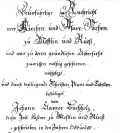 Pastors report 1784 / 1785 Pastors report 1784 / 1785
The pastor of Mestlin writes a church chronicle: "In-depth news of church and parish-matters in Mestlin and Ruest, and
what is necessary to know about the overview, set up and confirmed by enclosed documents, plans and tables, by Johann Clamor
Buchholz, at this time pastor in Mestlin and Ruest, written in the years 1784 and 85"
Pastor Buchholz put down the history of the village and its inhabitants in a unique way and meticulous completeness (216 pages). Buchholz covers, for
example the history of the churches of Mestlin and Ruest, their patrons, their architectural composition. He copied documents, described parish lands,
former and current parish villages and monastries of Mestlin. The part on the families of his monastry is of a special importance for geneological
research (see publication of 1938).
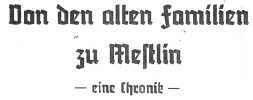 Reprint
1938 Reprint
1938
A part of the parish chronicle of Mestlin (see publicationn 1784 / 85) by Johann Clamor Buchholz is
being printed under the title "Of the old families of Mestlin - a chronicle" in the framework of a series called "sources to the rural
court- and geneological research".
For three periods of time (until 1648, 1648-1704, 1704-1785), the peasants and inhabitants of Mestlin, Ruest and Mühlenhof are being listed.
Appearing special features are being interpreted and commented. 16 families, "that are the strongest" are being documented in great detail:
Behrens, Cords, Dieckmann, Dolge, Eckelberg, Ehmck(e), Garling, Hohe, Kröger, Nehls, Soltau, Soltwedel, Wel(t)zin, Westphal, Wiese,
Zülock(Sülck).
A map from 1777 shows 15 peasanties in Mestlin, additionally the estate at the church, a forestry court and
two courts of the mayor.
1783; In Mestlin live: Johann Eckelberg, H. J. Garling, Ehmck, Köpcke, Hans Adam Nehls, Westphal, Hans
Jacob Kröger, Jochim Nehls, Johann Kröger, Johann Karl Wiese, Friedrich Garling, Soltwedel, Friedrich Cords, H. J. Eckelberg.
- May 18th, 1792
- Prohibition of emigration to America for the subjects of Mecklenburg- Schwerin by grand-ducal decree.
1793 Johann Adam Schulz becomes pastor of Mestlin / Ruest
1803 House-people and cottage-owners in Ruest are: Schulze Hahn, Friedrich Wiese, Hans Sternberg, Michel
Sternberg, Borchert, Krüger Rieck, Zülck, Stüdemann, Friedrich Cords.
- 1806
- escape of Blücher through
Lootings, destructions by the French
- 1806 - 1813
- French time
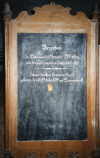 entry into membership of the
napoleon Rhine union in 1808, billetings, forced recruitment for the fight against Russia in 1812: 2100 people from Mecklenburg (Schwerin: 1700,
Strelitz: 400). Less than a hundred survive. In 1813, both parts of Mecklenburg leave the Rhine union. entry into membership of the
napoleon Rhine union in 1808, billetings, forced recruitment for the fight against Russia in 1812: 2100 people from Mecklenburg (Schwerin: 1700,
Strelitz: 400). Less than a hundred survive. In 1813, both parts of Mecklenburg leave the Rhine union.
- 1813 - 1815
- War of independence against Napoleon
1808 - 1815 memory board for veterans in the church of Mestlin
- June 8th, 1815
- The German Federal File allows (through article 18b) the emigration to other states of the German Union
- 1815
- congress in Vienna
Mecklenburg-Schwerin and Mecklenburg-Strelitz become grand-duchies and members of the German union.
1816 Martin Joachim Jakob Heydemann becomes pastor of Mestlin / Ruest
- 1817 / 1820
- Mecklenburg-Schwerin has 393.000 inhabitants (1820) and Mecklenburg-Strelitz has 72.000 (1817)
- January 18th, 1820
- annullment of serfdom in Mecklenburg, as of Easter 1821, is being announced
- April 4th, 1822
- Decree over seperation and heriditary-leaseholding of the peasantries
1828 the leaseholder of Mestlin (including Vimfow and Kadow), Sauerkohl leases Zidderich with Steinbeck as
well
1830 Johann Heinrich Birkenstädt becomes pastor of Mestlin / Ruest
In1830, Mestlin has 12 3/4-"Hüfner", parish church, forester, windmill,
"Klosterkrug", blacksmith's shop, brickyard, and school and Ruest has 9 3/4-"Hüfner", church, school and "Erbkrug".
In connection with the change from the three-field-farmstead to the effective enclosure-farmstead, the 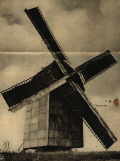 acre pieces of the farmers are divided up all over. On Johanni 1833 the 12 peasants of Mestlin are being settled over to Ruest. From the unsecure status as time-leaseholders they now became
heriditary-leaseholders. From now on, Mestlin was a pure estate village, whereas Ruest was being upgraded to a big peasants' village, Ruest had 25
peasantries. At this time, the leaseholder of Mestlin is Karl Sauerkohl. acre pieces of the farmers are divided up all over. On Johanni 1833 the 12 peasants of Mestlin are being settled over to Ruest. From the unsecure status as time-leaseholders they now became
heriditary-leaseholders. From now on, Mestlin was a pure estate village, whereas Ruest was being upgraded to a big peasants' village, Ruest had 25
peasantries. At this time, the leaseholder of Mestlin is Karl Sauerkohl.
In1834, the step mill was built in Mestlin. Far visible it could still be the famous landmark of Mestlin,
unfortunately it burnt down in 1945.
1835 the fair justice, that Mestlin was entitled to until then, was transferred to Ruest.
- September 3rd, 1847
- A grand-ducal decree rules the procedure for giving away passports to emigrants in Mecklenburg-Schwerin
- 1848 / 1849
- Revolution
- February 5th, 1849
- A grand-ducal decree rules the "general repeal of taxes for emigrants" ... for the state of Mecklenburg-Schwerin
- 1851
- Beginning of the mass emigration to America
Political, social and economical problems caused the great emigration wave, at the end of the 19th century. From 1853 till 1908, almost 120,000
people emigrated from Mecklenburg.
- June 1st, 1853
- Decree over the acquisition and the loss of a subject from Mecklenburg is being passed
1857 Mestlin has 240 inhabitants, court, parish church, school, forestry, mill, "Krug",
blacksmith's shop, and a brickyard (Ruest: 443 inhabitants, school, blacksmith's shop, and "Erbkrug").
- April 15th, 1857
- sovereign decree over the emigration to outer-european countries
1861 the lease-holder Hans Dehns takes over the estate.
- June 25th, 1867
- The constitution of the North-German union becomes binding upon both parts of Mecklenburg
With the founding of the North-German Union in 1867, a new era begins for Mecklenburg. The constitution grants total freedom within the states of
the North-German union, as well as in in the cross-border traffic for all union-members. The existing marriage restrictions are dropped. Mecklenburg was
connected with the north-german mail- and telecommunication net and receives standardized measures and weights on the basis of the metric system, and
the bank notes of the union. The military of Mecklenburg was placed under prussian command.
- 1868
- Both parts of Mecklenburg become members of the customs union
1869 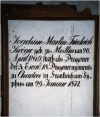 The lease-holder of Mestlin, Hans Dehns, takes over Vimfow as well.
The lease-holder of Mestlin, Hans Dehns, takes over Vimfow as well.
- 1870 - 1871
- German-French War
with participation of troups from Mecklenburg
1871 memory board in the church of Mestlin for the dead.
- 1871
- Founding of the German Empire, both Mecklenburg-Schwerin (558,000 inhabitants) and Mecklenburg-Strelitz (97,000 inhabitants) become member
states.
1872 Ludwig Heinrich Hunzinger becomes pastor of Mestlin / Ruest
 1877Monastry
office Dobbertin 1877 - is the inscription on this board at the front side of a building. In the 70ies of the 19th century, the houses (see picture
below) of the day-laborers of the estate were built along the village street (today: Fritz-Reuter-Str., Goldberger Str.). 1877Monastry
office Dobbertin 1877 - is the inscription on this board at the front side of a building. In the 70ies of the 19th century, the houses (see picture
below) of the day-laborers of the estate were built along the village street (today: Fritz-Reuter-Str., Goldberger Str.).
1894 the lease-holder of Mestlin is H. Dehns.
Important historic book
"Mecklenburgische Vaterlandskunde", by Wilhelm Raabe, Wismar 1894 is written about Mestlin:
Mestlin, post station, 1 1/4 mile to the west of Goldberg, important junction of our avenue-traffic, since the four avenues from Parchim, Crivitz,
Sternberg and Goldberg unite here. To the south of the forest of the monastry of Dobbertin.
Lease-court of H. Dehns (blacksmith's shop).
village with parish church, school (2), forester, mill, "Krug", brickyard, court and village 887,7 hectare. 295 (240) inhabitants
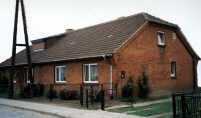 The following anecdote
from the "Mecklenburg Buch" by E. Schulz (Hinstorff Verlag, 1938) could be from this time from Mestlin: The following anecdote
from the "Mecklenburg Buch" by E. Schulz (Hinstorff Verlag, 1938) could be from this time from Mestlin:
A boy of maybe seven years from an estate village came late to school, because he overslept. The teacher asked him, when he went to bed. "I
dunno," was the answer. The teacher replies: "Was it dark out?" After a short moment, the boy replied: "We could still plow."
1895 Karl Axel Walter pastor of Mestlin / Ruest
At the end of 1895 there were 270 people living in Mestlin, and 305 in Ruest.
- 1897
- imperial law that ruled emigration
Around the turn of the century, Hans Dehn is lease-holder of Mestlin.
Documentary book written around the turn of the century
 How could the village Mestlin have looked like around the turn of the century? An unemployed from Berlin (name is unknown),
that somehow got to an estate in Mecklenburg, describes his experiences: "Life of a farm-walker in Mecklenburg". How could the village Mestlin have looked like around the turn of the century? An unemployed from Berlin (name is unknown),
that somehow got to an estate in Mecklenburg, describes his experiences: "Life of a farm-walker in Mecklenburg".
With simple words he characterizes the people he meets: inspector, farmhands, maids, day-laborers and farm-walkers (... in the point of view of a person
from Mecklenburg are the farm-walkers coming here of no good what-so-ever. ...), he describes the village, the manor, Lüstuw, cottages, ... and the
daily life of the people. (picture on the right: picture postcard from Mestlin, approx. 1905)
- August 1st, 1914 - November 11th, 1918
- World War I
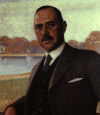 1917Bernhard
Berckemeyer (picture on the right, 1937 in Weisin) leases the estate Mestlin. Owner is the monastry of Dobbertin. A year later, the entire property of
the monastry is being taken over by the state. 1917Bernhard
Berckemeyer (picture on the right, 1937 in Weisin) leases the estate Mestlin. Owner is the monastry of Dobbertin. A year later, the entire property of
the monastry is being taken over by the state.
B. has been leasing the estate of Weisin near Lübz since 1906. In 1936 he buys the former estate of his parents in Gr. Thurow back.
In 1917, Mestlin was in a very bad shape. The approx. 60 families led a hard life. In the middle of the 20-ies, B. irrigates big areas in order to build
the estate up again. B. hired the governor Briese for Vimfow, for Mestlin he hires the horse governor Prestin. At that time, Hahn was the governor of
Mestlin.
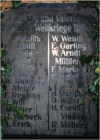
1914 - 1918 Again, there are victims among the people from Mestlin: memory board on the cemetery.
- November 14th, 1918
- abdication of the grand-duke
- 1918
- Takeover of the administration of the monastry of Dobbertin by the free state Mecklenburg-Schwerin
1918 Friedrich Wehner becomes pastor of Mestlin / Ruest
- 1918 / 1919
- Founding of the free states Mecklenburg-Schwerin (1919) and Mecklenburg- Strelitz (1918) as member states of the republic of Weimar
- 1925
- Mecklenburg-Schwerin has 674,000 inhabitants, Mecklenburg-Strelitz has 110,000
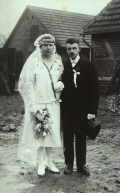 1926
B. Berckemeyer realizes extensive irrigation measures in Mestlin. 1926
B. Berckemeyer realizes extensive irrigation measures in Mestlin.
Property lease-holder Major a. D. Berckemeyer was the leading force in the soldier union of Mestlin. The union arranged a number of
social events (soldier dances, meetings, children's fairs).
A marriage in Mestlin (Hermann Konow, cartwright, 1927)
1934 Otto Schmidt becomes pastor of Mestlin / Ruest
- 1933
- Both parts of Mecklenburg have 805.000 inhabitants
- 1934
- Combining of both parts of Mecklenburg to the district Mecklenburg
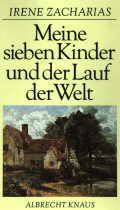 Book written 1986 Book written 1986
In 1986, the autobiography of Irene Zacharias is published under the title: "My seven children
and the course of the world" (267 pages).
Irene Zacharias, born in 1903 in Berlin marries the peasant Paul Holz in Poitendorf near Parchim in 1924. In 1938, the family
takes over a farm in Ruest, that's 200 Morgen big (a "Morgen" is an obsolescent unit of measurement comprising between 2,500 and 3,400 square
meters). There she lives until 1951. In simple moving words she describes her experiences and thereby the conditions of that
time in Mestlin and Ruest. Mentioned are for example the neighbors Wahrmann and Ehmcke, the peasants Nehls, Dollase, Peglau, Radke, the peasants' wives
Elsa Welzin, Ida Rinsche, the landlord Brennke, the mayor Martens. In the foreground however, stands the history of her family, the history of her eight
children.
1939 Friedrich Heise becomes pastor of Mestlin / Ruest
Mestlin has 1939 369 inhabitants
In 1939, Mecklenburg has 900,593 inhabitants
- 1939 - 1945
- World War II
 |



 entry into membership of the
napoleon Rhine union in 1808, billetings, forced recruitment for the fight against Russia in 1812: 2100 people from Mecklenburg (Schwerin: 1700,
Strelitz: 400). Less than a hundred survive. In 1813, both parts of Mecklenburg leave the Rhine union.
entry into membership of the
napoleon Rhine union in 1808, billetings, forced recruitment for the fight against Russia in 1812: 2100 people from Mecklenburg (Schwerin: 1700,
Strelitz: 400). Less than a hundred survive. In 1813, both parts of Mecklenburg leave the Rhine union. acre pieces of the farmers are divided up all over. On Johanni
acre pieces of the farmers are divided up all over. On Johanni  The lease-holder of Mestlin, Hans Dehns, takes over Vimfow as well.
The lease-holder of Mestlin, Hans Dehns, takes over Vimfow as well.
 The following anecdote
from the "Mecklenburg Buch" by E. Schulz (Hinstorff Verlag, 1938) could be from this time from Mestlin:
The following anecdote
from the "Mecklenburg Buch" by E. Schulz (Hinstorff Verlag, 1938) could be from this time from Mestlin:


